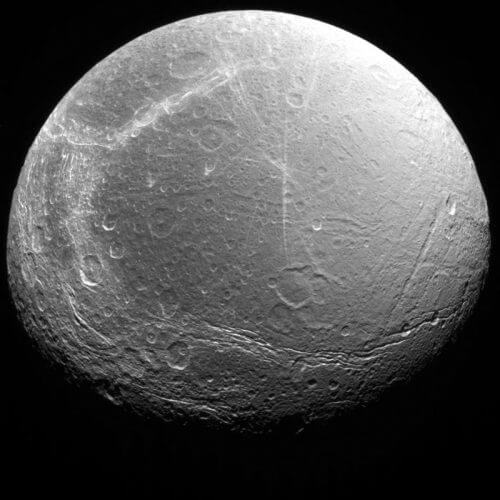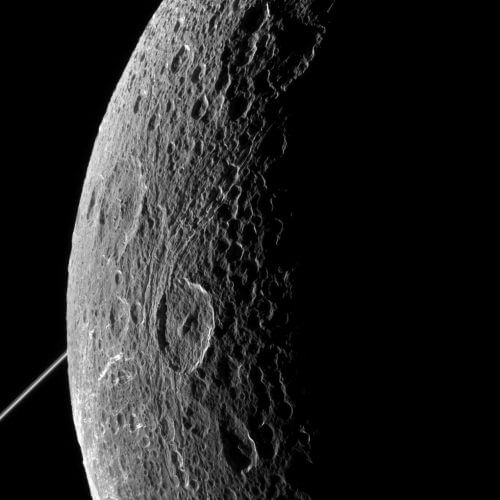New findings from the study of the Moon Discussion of Saturn

During the years that the Cassini spacecraft tracked, photographed and measured Dion, it became clear that this moon, during its orbit around Saturn, is inside a band made of particles similar to the Van Allen belts that surround the Earth. These particles are hot and moving at high speed. During their movement, they hit the layer of water ice that covers parts of Dion's land surface. In this impact, they break up the water molecules and spray upwards oxygen atoms. Since this process continues for a long time and continuously, it creates a kind of atmosphere that surrounds the moon. It is not an atmosphere like that of the Earth and not even like that of Mars. This is a very thin layer. Dion's atmosphere is 5 trillion times less dense than Earth's. It has 2250 ions of oxygen per 0.33 cc. An additional supply of oxygen can come from energetic particles coming from the apricot that also bombard the ground and release oxygen ions that are splashed upwards (1,2).
Since this is an extremely thin gas mantle and it must have been built up over hundreds of millions of years, it is likely that additional oxygen supply should come. Where can she come from? A possibility that must be taken into account is from inside the moon. In this case, the obvious conclusion is liquid water, although there are researchers who estimate that there is a water ocean in question 100 km below the surface and that it is tens of kilometers deep (3). It is estimated that this sky has been there almost since the formation of the moon.
Let's go one step further. Tidal forces are exerted on this moon both by Saturn itself and by other moons that are more distant from Saturn and create resonance conditions with it. This water heats up and bursts out and freezes. It could also be that some of the water breaks down into its components and the oxygen atoms join the oxygen shell that surrounds Dion. It is possible that there were geyser eruptions on this moon in the past, such as the water geysers observed in Enceladus, and perhaps even today there are such eruptions (the author's hypothesis - Haim Mazar). It could be that the presence of water has significance in terms of the existence of life on this moon below the surface of the ground.

Geological activity
Supporting evidence for underground activity follows the discovery of a fine flow of particles from the moon, probably from underground water, and the photographs indicating the possible presence of a muddy layer or liquid beneath the lunar crust. The photographs also show ancient cracks similar to the cracks observed on Enceladus from which the geysers and organic material spew out. In some of the photographs, a ridge line was discovered that is 500 km long and 2-1 km high. This ridge line was named Janiculum Dorsa. The crust of the moon beneath this mountain appears to have contracted under the weight of the mountain. This situation raises the possibility that the crust in this place accumulated heat during the building of the mountain. Dion also heats up due to its contraction and expansion during its distance from and approach to Saturn while moving around it. The expansion and contraction are very small, but they are enough to cause significant warming (4).
In another part of the photographs of the moon, you see strips and brightness that extend for hundreds of kilometers and their sides and depth are hundreds of meters. It seems that these are grabens, the subsidence of the ground in their center revealed large ice blocks of the crust (5).
Sources
- Brian Handwerk – “Saturn moon has thin atmosphere, astronomers discover"10.9.2011
- Stephen Clark – “Cassini detects oxygen around second Saturn moon"4.3.2012
- Brooks Hayes – “Cassini data reveal subsurface ocean on Saturn's moon Dione"5.10.2017
- Cassini finds hints of activity at Saturn's moon Dione"30.5.2013"
- Stephen Clark – “Saturn moon's ice canyons viewed by Cassini"18.6.2015

2 תגובות
As far as I know, no evidence of water molecules has been found in the measurements made by the Xsini. Maybe these will find some future task for discussion.
There should also be water molecules in such an atmosphere due to sublimation of the ice.